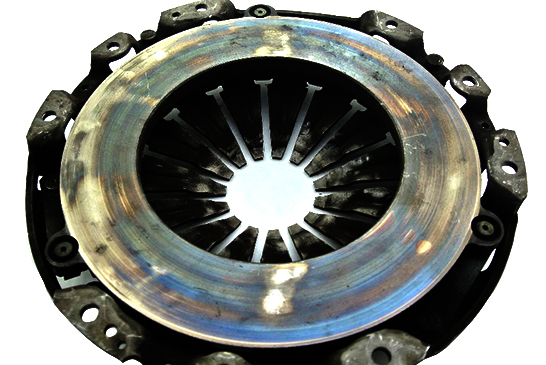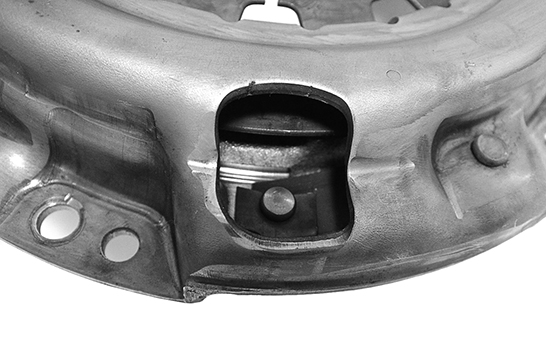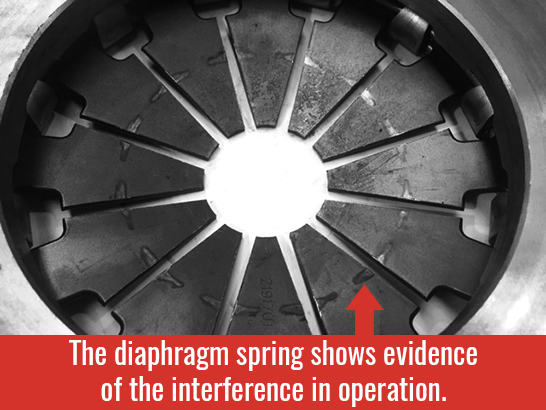Trouble Shooting » Clutch Cover » Engagement & disengagement
Commercial Clutch Brake Not Working
Indicator:
No dis-engagement
Cause:
Clutch brake not operating (Pull-Type Commercial Clutch)
Effect:
1. Worn cross shafts
2. Worn cross shaft bushes in bellhousing
3. Worn or damaged clutch fork
4. Excessive wear on release bearing housing
Action:
1. Replace clutch kit
2. Replace cross shafts
3. Replace cross shaft bushes
Bent Straps
Indicator:
Unable to dis-engage the clutch
Cause:
1. Improper driving practice.
2. Sudden down changing of gears i.e. 5th gear to 2nd gear.
3. Constant “dropping” of clutch at extremely high RPM when taking off.
4. Poor handling/shipping practises
Effect:
Bent drive/lifting straps
Action:
1. Renew clutch kit
2. Driver education
Warped Clutch Cover
Indicator:
Slipping/Poor clutch performance
Cause:
1. Excessive heat caused the pressure plate surface fatigue.
2. Only replaced the clutch disc and pressure plate was not assessed.
Effect:
Warped clutch cover pressure plate assembly
Action:
1. Replace the clutch kit

Retractor Clip Dislodged/Stretched
Indicator:
No gear selection/difficult engagement
Cause:
Retractor clip has become dislodged/stretched
Action:
1. Over adjustment of clutch has caused the stretching of the retractor clip
2. The pressure plate has been dropped
3. The pressure plate has been damaged in transit
Action:
1. Replace clutch cover
2. Inspect the clutch operating adjustments
3. Always practice safe handling of the cover when fitting
4. Inspect the clutch cover prior to fitment to ensure there are no retractor clip issues.

Worn Clutch Disc Facing and/or Dirt Lodged Between Diaphragm Spring & Clutch Cover
Indicator:
Slipping clutch/Engagement and Dis-Engagement Problems
Cause:
- Bell housing has not been degreased and cleaned. Poor installation of the new clutch. The new clutch disc has not worn but fibres have become lodged in the new clutch cover are that of the previously worn clutch. It is a requirement due to ventilation designs that the bell housing area free from old fibres, dirt and grease when installing new clutch.
- This problem is common in 4 wheel drive vehicles when an inspection cover or a clutch fork cover boot has not been Inspected for re-use or replaced when installing a new clutch.
Effect:
Worn clutch disc facing fibres and/or dirt lodged between diaphragm spring and clutch cover housing causing loss of cover clamping force.
Action:
- Ensure the bell housing and back of the engine are thoroughly degreased and cleaned of foreign material before installing a new clutch.
- Ensure inspection locations are sealed correctly with any boots thoroughly inspected for re-use and if necessary replaced. (Note: These problems are common on farm vehicles, vehicles travelling on sand and 4x4 recreational vehicles.)

Pressure plate- heat patched
Indicator:
Slipping/Shudder, Poor clutch performance
Cause:
- Overloading the clutch
- Overloading the vehicle
- Incorrect clutch free travel
- Clutch control failure (Hydraulic/Cable)
- Driver error
Effect:
Pressure plate casting has heat deterioration.
Action:
- Replace clutch kit and machine flywheel
- Check clutch control mechanisms and if necessary repair or replace
- Driver education

Tilted release plate
Indicator:
Non-Release (Clutch Drag)/Pedal Vibration
Cause:
- Poor fitting practices (lever strut has become dislodged when fitting)
- Clutch lever fatigue due to incorrect free travel
Effect:
Release lever plate uneven (when bolted to the flywheel)
Action:
- Replace clutch kit
- Check clutch control system and repair or replace if necessary
- Check and adjust clutch free travel
Broken Retractor Clips
Indicator:
No gear selection/difficult dis-engagement.
Cause:
Stretched and damaged retractor clip (Clip stretched above diaphragm).
Effect:
After installation of new clutch, unable to select gear.
Action:
- Fit new cover assembly
- Adjust clutch to manufacturer’s specifications.
- Always check components before fitting and ensure that the tip of retractor clip is resting on top of the diaphragm.

Diaphragm fouled on clutch disc
Indicator:
Difficult to engage/disengage gear, grating noise and hard pedal at the end of the operating stroke.
Cause:
- Flywheel depth or step incorrect
- Clutch thrust bearing has fallen off the gearbox nose cone slide.
- Clutch disc too thick
- Incorrect clutch free travel (too much pre-load)
- Faulty clutch hydraulics
Effect:
Diaphragm fouled on clutch disc. Crashing in gear and unable to obtain clutch adjustment.
Action:
- Check flywheel depth or step incorrect
- Check for wear or damage to the gearbox nose cone slide
- Check clutch disc thickness
- Check clutch hydraulics and replace if necessary
- Adjust clutch free travel to manufacturers specifications


Trouble Shooting
- Clutch Cover
-
Clutch Disc
- Difficult Disengagement(10)
- Loss of Drive(5)
- Noise & Vibration(3)
- Other(2)
- Shudder (judder)(3)
- Slipping(6)
- Clutch Master Cylinder(1)
- Clutch Slave Cylinder(1)
- Clutch Spigot Bearing, bush (pilot bearing)
-
CSC (concentric slave cylinder)
- CSC Leaking(1)
- Loss of Fluid(5)
- Other(1)
- Flywheel
- Thrust Bearing
- Vehicle Diagnostics(6)





